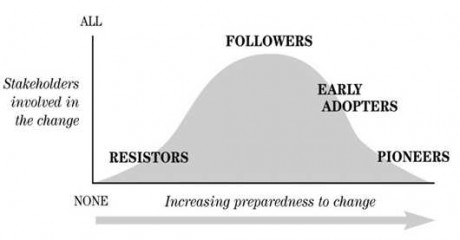
“It is not the strongest that survive, nor the most intelligent, but the one most responsive to change.”
This rule applies to all of us in today’s world – we must try to adapt to change not only to survive, but to thrive, or grow because of it.
So what is change management?
Change management is a structured approach in individuals, teams, churches, other organisations and societies that enables the transition from a current state to a desired future state. From an individual perspective, change may be a new way of doing something. From a societal perspective, change may be a new government policy or the passing of a new law. Successful change, however, requires more than a new process. It requires the engagement and participation of the people involved.
The change management process flow diagram shown above was popularised by Everett Rogers in his book Diffusion of Innovations. Rogers argues that diffusion is the process by which innovation is communicated over time to the participants in a social system and offers a simple model of how people typically react to change. Let’s use a church as an example.
Pioneers
Pioneers like change and often all things “new” because it gives them something fresh to explore. They are generally perceived as a little too curious, but they account for a large majority of ideas and new approaches, even though they may be only 2-5% of the population.
Early Adopters
Early Adopters pay close attention to the Pioneers, and have the ability to more widely communicate the best of the Pioneer’s ideas to the rest of the church. The early adopters are a little more cautious about new approaches and change than pioneers but not by much. However they will typically make up 15-20% of any given church.
Followers (sometimes also called Late Adopters)
Followers want things to be main stream before they will accept a change. Usually this is done by watching the early adopter experience over a reasonable amount of time and making sure that any problems and difficulties have been “ironed out”. About 60% of the people in a church are followers.
Resistors (sometimes also called Laggards)
Resistors will generally stay with what they have “always done” even if it is fairly obvious to everyone else that a new way is better. Some may even actively resist a change to hold on to the familiar or the tried and trusted ways. They look at changes with suspicion and adopt the innovation only when it has become a tradition itself. Resistors typically account for around 15-20% of any given population.
The first step in any change management process is to correctly identify the people you are working with so the appropriate strategies can be used. All attempts to create change depend on the correct interpretation of the behaviours of each group.



Comment here